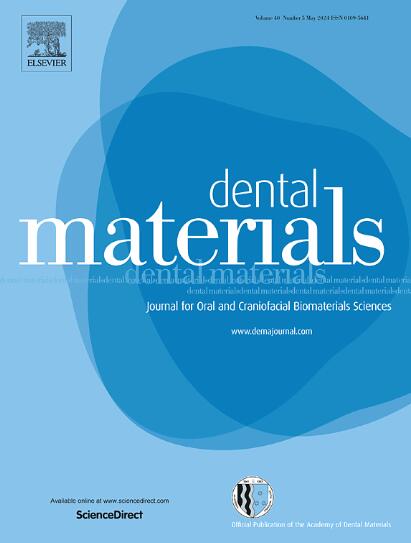Synergetic effect of ZnO-doped dendritic porous silica and barium glass powder as functional bimodal fillers for dental composite applications
IF 6.3
1区 医学
Q1 DENTISTRY, ORAL SURGERY & MEDICINE
引用次数: 0
Abstract
Objective
Porous silica particles have received attention in dental composites owing to their ability to form micromechanical matrix/filler interlocking and serve as the suitable carrier materials. The aim of this work is to develop structural-functional integrated ZnO-doped dendritic porous silica (ZnO-DPS) and investigate the effects of filler morphology and formulations on the physicochemical and antibacterial properties, cytotoxicity, and radiopacity of dental composites.
Methods
Various ZnO-DPS particles (ZxUy) were synthesized with a one-pot self-assembly route by adjusting the amounts of zinc nitrate hexahydrate (Z) and urea (U) in the microemulsion, respectively. Their morphology and structure were characterized by the electron microscopy, X-ray powder diffraction, X-ray photoelectron spectroscopy, and N2 adsorption and desorption isotherms. The mechanical property of dental composites containing optimal Z0.5U1.8 and its bimodal fillers with silanized barium glass powder (BGP) were measured by a universal testing machine. The real-time degree of conversion, polymerization shrinkage, antibacterial rate, cytotoxicity, and radiopacity were further evaluated.
Results
The optimal Z0.5U1.8 particles with complete spherical morphology and hierarchical porous structure were obtained. Functional bimodal fillers were further formulated to address the loading limitation of Z0.5U1.8 (10 wt%). Among all materials, the Z7B53 composite (Z0.5U1.8: BGP = 7:53, wt/wt, filler loading: 60 wt%) showed excellent mechanical performance, giving large improvements of 54.3 %, 272 %, and 18.8 % for flexural strength, flexural modulus, and compressive strength, respectively, compared with the unfilled resin. Meanwhile, this composite exhibited lower shrinkage (3.43 ± 0.01 %), higher radiopacity (1.60 mm Al), and better cell viability compared to the unfilled resin and the unimodal Z7B0. The antibacterial rate of Z7B53 is 93.0 ± 1.9 %.
Significance
The preparation of ZnO-DPS particles and the design of unimodal and bimodal fillers could provide a better understanding of the relationship between filler formulations and composite properties.
zno掺杂枝晶多孔二氧化硅和钡玻璃粉作为功能性双峰填充剂在牙科复合材料中的协同作用。
目的:多孔二氧化硅颗粒因其能形成微力学基质/填料联锁并作为合适的载体材料而在口腔复合材料中受到广泛关注。本工作的目的是开发结构功能集成的zno掺杂枝晶多孔二氧化硅(ZnO-DPS),并研究填料形态和配方对牙科复合材料的物理化学和抗菌性能、细胞毒性和放射性的影响。方法:通过调整微乳液中六水硝酸锌(Z)和尿素(U)的用量,采用一锅自组装的方法合成各种ZnO-DPS颗粒(ZxUy)。通过电子显微镜、x射线粉末衍射、x射线光电子能谱、N2吸附和脱附等温线对其形貌和结构进行了表征。采用万能试验机测试了Z0.5U1.8及其硅化钡玻璃粉(BGP)双峰填料牙科复合材料的力学性能。进一步评价实时转化率、聚合收缩率、抗菌率、细胞毒性和放射透明度。结果:制备的Z0.5U1.8颗粒具有完整的球形形貌和分层多孔结构。进一步配制功能双峰填料,以解决Z0.5U1.8(10 wt%)的负载限制。在所有材料中,Z7B53复合材料(Z0.5U1.8: BGP = 7:53, wt/wt,填料载荷:60 wt%)表现出优异的力学性能,与未填充的树脂相比,其抗弯强度、抗弯模量和抗压强度分别提高了54.3% %、272 %和18.8% %。同时,与未填充树脂和单峰Z7B0相比,该复合材料具有更低的收缩率(3.43 ± 0.01 %),更高的辐射不透明度(1.60 mm Al)和更好的细胞活力。Z7B53的抑菌率为93.0 ± 1.9 %。意义:ZnO-DPS颗粒的制备以及单峰和双峰填料的设计可以更好地理解填料配方与复合材料性能之间的关系。
本文章由计算机程序翻译,如有差异,请以英文原文为准。
求助全文
约1分钟内获得全文
求助全文
来源期刊

Dental Materials
工程技术-材料科学:生物材料
CiteScore
9.80
自引率
10.00%
发文量
290
审稿时长
67 days
期刊介绍:
Dental Materials publishes original research, review articles, and short communications.
Academy of Dental Materials members click here to register for free access to Dental Materials online.
The principal aim of Dental Materials is to promote rapid communication of scientific information between academia, industry, and the dental practitioner. Original Manuscripts on clinical and laboratory research of basic and applied character which focus on the properties or performance of dental materials or the reaction of host tissues to materials are given priority publication. Other acceptable topics include application technology in clinical dentistry and dental laboratory technology.
Comprehensive reviews and editorial commentaries on pertinent subjects will be considered.
 求助内容:
求助内容: 应助结果提醒方式:
应助结果提醒方式:


